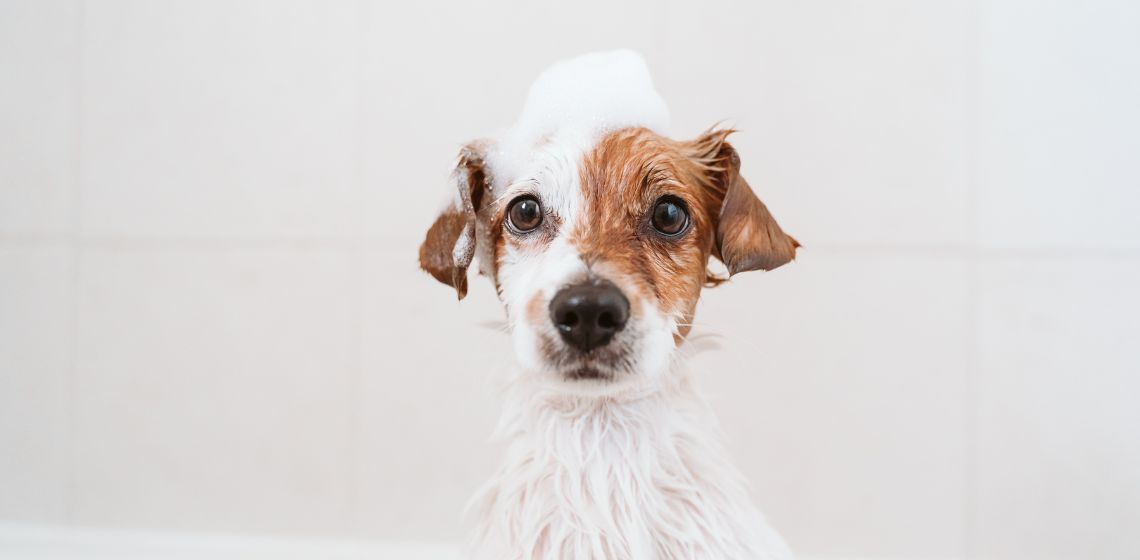Table of Contents
When Can You Bathe a Puppy?
You can bathe your puppy at any age, though their mother will take care of cleaning puppies when they’re first born until they’re a few weeks old. However, if your newborn puppy gets into something smelly or makes a mess, you can use a clean, warm washcloth to gently remove any dirt or debris. Older puppies can be bathed at any time, though you want to take care not to bathe them too often to avoid dry skin. You also want to make sure to avoid getting water into your puppy’s eyes, ears, nose, and mouth.
What Supplies Do You Need to Wash a Puppy?
A puppy bath needs a few supplies. If your puppy is very small, set up a pot or bucket in a sink and fill it with warm, soapy water. You’ll want to use a shampoo specifically made for puppies or that has oatmeal or aloe in it to avoid drying out your puppy’s skin. These special shampoos are also less abrasive and won’t irritate your puppy’s eyes if some soap gets into them.
If you’re giving a flea bath to puppies, make sure the flea shampoo is appropriate to use on a puppy, and that your puppy meets the minimum age requirement to use it. For any bath, you’ll also want clean, warm water to rinse your puppy with, or a good sink sprayer. Finally, a warm fluffy towel is best for helping dry off your puppy and to keep your puppy from shivering after their bath.
How to Bathe a Puppy for the First Time
Your puppy’s first bath might seem scary, but it doesn’t have to be. Before bathing your puppy, take the time to get them used to the bathing experience. Place them in the tub or sink, and feed them several of their favorite treats while giving lots of praise. From there, you can turn on the water, talk calmly and gently, and give more treats. Go slowly, taking time to carefully rinse out any soap, and avoid getting water in your puppy’s eyes, ears, and mouth.
If your puppy seems in distress during the bath, you may want to take a break from bathing them. Try bathing your puppy again a short while later, taking the time to offer treats and praise so the bath is seen as a positive experience.
In the case of a puppy that is very fearful, break the bath down into several steps. First, get your puppy used to the tub where you’ll be washing them. Then, turn on the water without rinsing or bathing your puppy. Next, gently cup some warm water over your puppy and mimic rubbing soap into their coat. Finally, combine all the steps together, offering praise and treats with each. You can use pet or baby wipes to help remove any remaining dirt or debris. They’re also useful for quick cleans in between baths.
How to Dry a Puppy After a Bath
Once you’ve finished rinsing the soap from your puppy’s coat, you’ll want to dry them. Drying is important if you notice your puppy shivering after a bath. A warm fluffy towel is a great way to dry them off. You can also use a hair dryer to help fluff and dry your puppy. Be sure to keep it on its lowest setting to avoid accidental burns and reduce noise that might scare your puppy. Giving treats as you dry them with the hair dryer or towel can also help make the experience more enjoyable.
You may also notice your puppy shaking after a bath — this is their own way of drying! It helps to shake off excess water droplets, so be sure to place your puppy in an area that is easy to clean or where walls won’t be damaged by water.
Your puppy’s first bath may be an anxious experience, but it doesn’t have to be! By taking things slowly, offering lots of treats, and taking the time to make it a fun experience, baths can become a regular, easy part of caring for your new best friend. Puppies are great at getting dirty, but with the right tools and plan, you can help keep them, and your home, clean.
Frequently Asked Questions
You can bathe your puppy at any time, especially if they are covered in dirt. However, it is best to give your puppy a regular bath every 3-4 weeks. This is enough time to allow the natural oils on your puppy’s coat to replenish and prevent irritation or drying of the skin.
Bathing a puppy can be done at any age. For newborn or very small puppies you will want to take care not to get any water in their faces. Using a small tub or basin for rinsing and holding them in your arms rather than placing them in a large tub can also make it easier to bathe a very small puppy.
It is fine to bathe your puppy at home before they are fully vaccinated. If you will be bringing your puppy to a groomer or bathing facility, they will need to be fully vaccinated. This is required by most groomers and is best to prevent the spread of any illness to your puppy in shared spaces.

Jessica is a lifelong lover of animals. A 2009 graduate of Animal Sciences at Oregon State University, Jessica has worked as a certified dog trainer, veterinary assistant, shelter medicine volunteer, and more. Her favorite areas of interest include behavior, critical and emergency care, and reproduction. Currently, Jessica enjoys gardening, writing, and spends her free time exploring new places with her dog, Libby, or cuddling with her cat, Chell.








